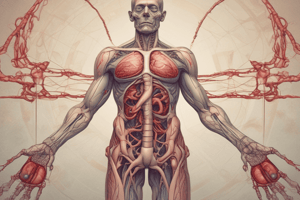Podcast
Questions and Answers
What is a thrombus?
What is a thrombus?
- Compromised blood supply causing tissue damage
- A detached intravascular mass carried by the blood to a distant site
- The inappropriate activation of the normal haemostatic process
- A solid mass of blood constituents formed in the vascular system (correct)
What is thrombosis?
What is thrombosis?
- Ischaemic necrosis due to occlusion of arterial supply or venous drainage
- A detached intravascular mass carried by the blood to a distant site
- Compromised blood supply causing tissue damage
- The inappropriate activation of the normal haemostatic process (correct)
What is an embolus?
What is an embolus?
- Ischaemic necrosis due to occlusion of arterial supply or venous drainage
- Compromised blood supply causing tissue damage
- The inappropriate activation of the normal haemostatic process
- A detached intravascular mass carried by the blood to a distant site (correct)
What is ischaemia?
What is ischaemia?
What is infarction?
What is infarction?
What does normal haemostasis allow blood to do?
What does normal haemostasis allow blood to do?
What is included in Virchow's triad?
What is included in Virchow's triad?
Flashcards
What is a thrombus?
What is a thrombus?
A solid mass of blood components formed within the circulatory system.
What is thrombosis?
What is thrombosis?
The inappropriate activation of the body's normal blood clotting process.
What is an embolus?
What is an embolus?
A detached mass that travels through the bloodstream to a new location.
What is ischaemia?
What is ischaemia?
Signup and view all the flashcards
What is infarction?
What is infarction?
Signup and view all the flashcards
What does normal haemostasis allow blood to do?
What does normal haemostasis allow blood to do?
Signup and view all the flashcards
What is included in Virchow's triad?
What is included in Virchow's triad?
Signup and view all the flashcards
Study Notes
- Thrombus is a solid mass of blood constituents formed in the vascular system.
- Thrombosis is the inappropriate activation of the normal haemostatic process.
- Embolus is a detached intravascular mass carried by the blood to a distant site.
- Ischaemia is compromised blood supply causing tissue damage.
- Infarction is ischaemic necrosis due to occlusion of arterial supply or venous drainage.
- Normal haemostasis allows blood to exist as fluid in normal vessels.
- Thromboembolic disease is caused by thrombosis, embolism, ischaemia, and infarction.
- Virchow's triad includes endothelial injury, alteration of blood flow, and hypercoagulability.
- Primary/genetic causes of hypercoagulability include factor V Leiden and antithrombin deficiency.
- Thromboembolism can cause DVT-PE and demonstrates adherence to the vascular endothelium and lines of Zahn upon histopathological examination.
Studying That Suits You
Use AI to generate personalized quizzes and flashcards to suit your learning preferences.





